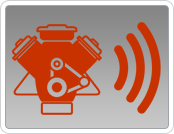
Virtual Racing since the 90's!
VGP3 Engine: the last chapter!

The VGP3 Engine
represents the latest and most comprehensive development of the technology at the core of the entire Virtual GP series. It serves as the simulation software that powers Virtual Grand Prix 3
, the last chapter of the Virtual GP saga. Built on top of the high-performance AVC vehicle simulation C++ library, the VGP3 Engine adds all the additional technologies required to transform the library into a full-featured car racing game/simulator.
The main features of the VGP3 Engine are:

Realistic simulation of different types of (race)cars; being based on AVC, the engine features an high level of realism especially on those key components that make the difference. For instance, the latest versions of the engine, based on the latest developments of AVC, implements a thermo-mechanical tyre model that can predict the real-time grip depending upon the asphalt and tyre characteristics (power spectral density of road roughness and polymer frequency/temperature response of tyre compounds).

Visualization module (A3e, the 3d engine), based on legacy OpenGL 2.1 specifications, offering realistic (energy conservation) outdoor lighting model, depending upon latitude and time-of-day, and sky/cloud rendering (Rayleigh and Mie scattering); the 3d engine has also support for true 3d stereoscopic vision.

Powerful audio engine, supporting spatialization and motion (Doppler) effects. The audio engine features an integrated granular synthesis algorithm, allowing the realistic reproduction of a car engine noise depending upon the real-time engine RPM and load.

Artificial Intelligence module that can drive/race almost any AVC vehicle on any track, including user-generated ones; thanks to an adaptive approach, computer-controlled opponents become faster with each practice session on any combination of vehicles/tracks. Progress is stored in a persistent database, making the AI a formidable challenge for human drivers, even on new tracks/vehicles.

Robust networking library, ANL, with advanced prediction and lag-compensation algorithms, allowing challenging multiplayer races and fierce tyre-to-tyre fights among human players.
Virtual Grand Prix 3 was released more than fifteen years ago, and nowadays is considered an end-of-life product. For this reason, it is no more commercially available. However, it is still internally maintained to test new features of the AVC physics library (still actively developed). If you want to give the realism of the AVC library a try, a build of the VGP3 Engine linked against a recent version of AVC is available in the Download section. Such a build is still based on legacy code, but physics simulation is updated to the latest improvements available so far.
- Virtual GP, Virtual Grand Prix 2 (VGP2), Virtual Grand Prix 3 (VGP3),
- the VGP3 Engine, and AVC are trademarks of Paolo Cattani.
- All Rights reserved.
- © 1999-2025 by Paolo Cattani.
- Windows and Windows 11 are either trademarks or registered trademarks of Microsoft Corp.
- Macintosh and Mac OS X are either trademarks or registered trademarks of Apple, Inc.
- All other trademarks or registered trademarks are property of their respective owners.